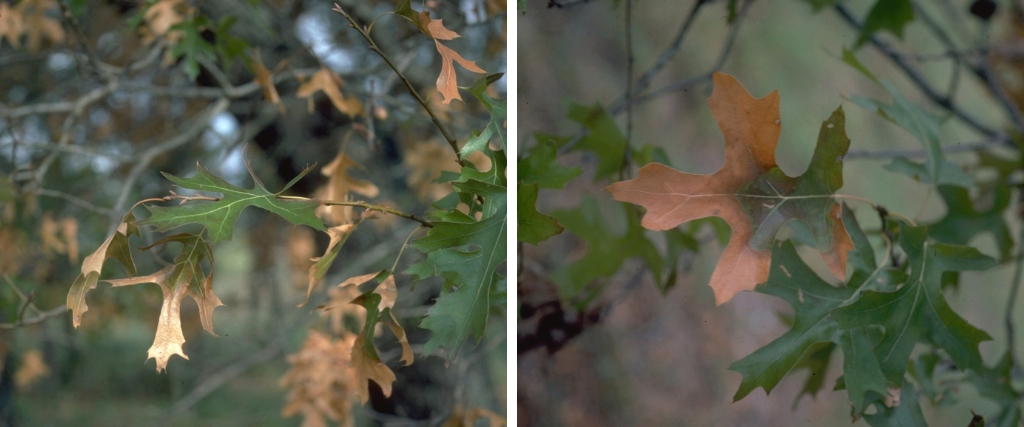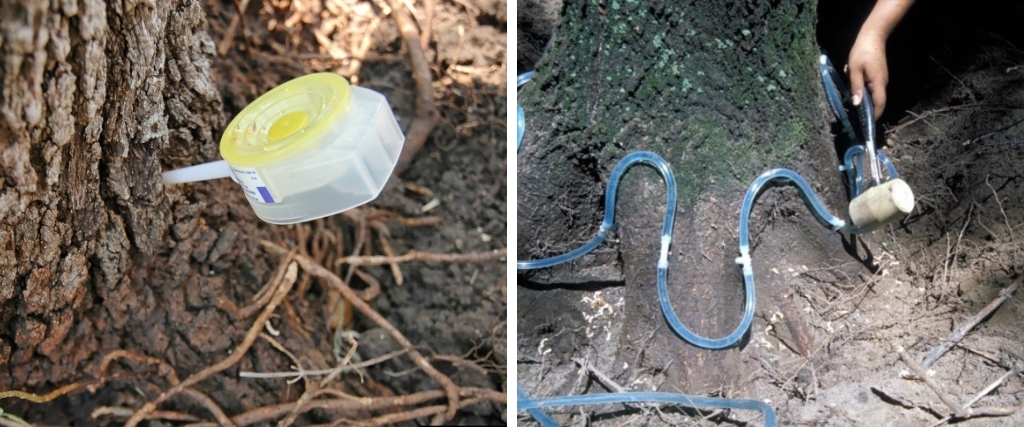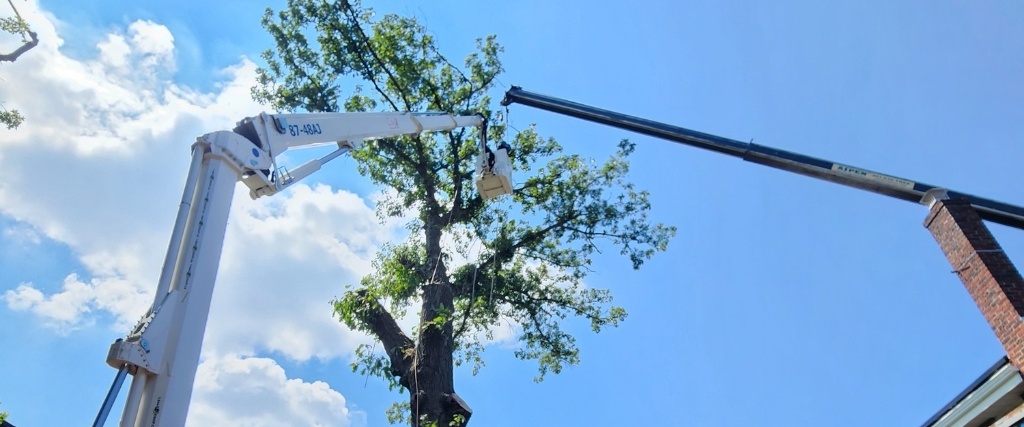Oak wilt is a serious fungal disease that spreads easily and quickly kills oak trees. There is no cure for this fatal disease so the only way to protect your oak trees is by taking preventive measures.
While there have been no verified cases in New Jersey as of the spring of 2024, we all must use best practices to avoid allowing it to spread to our forests and yards.
In this article, we describe eight of the most effective ways to prevent oak wilt from infecting your trees. From knowing when to trim your trees to understanding what to do if you suspect oak wilt, having the right plan and knowledge can be the difference between healthy and dead oak trees.
Key Methods to Prevent Oak Wilt
- There are no known cases of oak wilt in New Jersey at this time (May 2024).
- There is no cure for oak wilt, making prevention and early detection vital.
- Preventive measures include avoiding tree injuries, dressing wounds, separating roots, and fungicide treatments.
- Residents should also avoid purchasing oak saplings or logs from out of state.
- If you believe your tree is infected, contact a professional to analyze your tree and submit a sample to Rutgers University.

Pictures left and right: Oak wilt symptoms on oak leaves, image courtesy of Paul A. Mistretta, USDA Forest Service, Bugwood.org.
About Oak Wilt Disease
Oak wilt is a fungal disease caused by Bretziella fagacearum that affects red and white oak trees. The disease is fatal to trees and spreads through root grafts of oak trees within 50 feet of each other or transmission from sap-eating beetles, such as those in the Nitidulidae family, and oak bark beetles (Pseudopityophthorus spp.).
The most common symptoms of oak wilt include leaf discoloration and wilting, cracked bark (fungal growth may be visible beneath the bark), and early leaf drop and defoliation by as early as mid-August.
Unfortunately, once the symptoms become visible, it is likely too late to do anything to save the tree, making preventive measures vital to stop or slow the spread of the disease.
WARNING: There is no cure for oak wilt. Once a tree is infected, tree removal the only way to stop further infections.
Possibility of Oak Wilt in New Jersey
Rutgers University has maintained a watchful eye for the possibility of oak wilt in New Jersey. Although they have not yet identified a positive case, oak wilt is present in Pennsylvania and New York, making it only a matter of time before we see the disease in our state.
Prevention Methods for Oak Wilt Before It Arrives
With no cure, the only real tool we have to fight the disease is to prevent oak wilt from spreading. Much of our understanding of controlling and preventing oak wilt comes from agricultural programs in Texas where oak wilt is a common occurrence and has killed over one million trees.
1. Avoid Wounding Trees During the Growing Season
One of the primary infection methods comes from beetles that carry the disease into the tree by feeding on the sap in an open wound (areas not covered by bark). These beetles spread the fungal spores to the tree, where it infects and eventually kills the tree.
Damage to tree bark can be caused by many different factors, such as:
- tree pruning, particularly when pruning cuts are made incorrectly (e.g., flush cuts that remove the bark collar)
- holes from tree-climbing spikes (never allow the use of spikes on a live tree unless it’s being removed!)
- right-of-way pruning performed by utility companies and other contractors
- storm damage that breaks or cracks branches
- nailing signs on trees
- hanging hammocks or swings
- wounds caused by lawn mowers, string trimmers, and vehicles
- accidental damage to tree bark (for example, from falling trees).
Try to limit pruning to winter when oak trees are dormant, as leaving open wounds on your trees increases the possibility of oak wilt spreading. Typically, we see oak wilt spread most rapidly in April to July, although transmission can also occur until October when trees begin to go dormant.
If you must trim a tree between April and July, properly sanitize your pruning equipment before starting and between pruning cuts. Clean your cutting tools in a bleach solution, and repeat the process with every cut to decrease the chances of spreading the disease to other trees.
2. Use Wound Dressing to Prevent Oak Wilt Spread to Your Trees
PRO TIP: Under normal circumstances, we don’t recommend using wound dressing as it often slows the tree’s recovery process. However, when it comes to preventing oak wilt, it can be an effective way to prevent beetles from depositing fungal spores on open wounds.
Immediately cover any wounds with latex or commercial tree paint. Any latex paint that doesn’t have a rust inhibitor will get the job done and typically costs less than commercial wound dressings. Just be sure not to use oil-based paint as it can damage live tree tissue.
Because not all wounds are caused by planned activities, such as tree pruning, keep an eye on your oak trees for signs of damage that could act as an entry point for beetles to spread the fungus and cause oak wilt. Paint over those wounds as soon as you can. Or, if the damage is in a part of the tree that you cannot safely access, call a professional arborist with the specialized equipment needed to reach it.
Covering wounds this way can prevent beetles from “smelling” the fresh sap flowing from areas without bark cover, stopping them from contacting living tissue and infecting your tree.
We recommend only applying these wound dressings if a tree has a fresh wound during periods of rapid transmission: spring and early summer. Although, to be safe, it doesn’t hurt to apply tree paint throughout the entire growing season. And don’t forget to cover the outer sapwood of a stump in the case of entire tree removal.

Left to Right: Mauget Generation II microinjector; For injecting propiconizole fungicide for oak wilt prevention by Ronald F. Billings, Texas A&M Forest Service, Bugwood.org; Tree injection of photo by Joseph OBrien, USDA Forest Service, Bugwood.org
3. Apply Preventive Fungicide Treatments to Stop Oak Wilt in Its Tracks
Systemic fungicide injections can make trees more resistant to the disease and limit the risk of oak wilt infection.
While fungicide can kill the fungus that causes oak wilt, the internal damage suffered by previously infected trees is not reversible. For that reason, fungicide treatments can only be used as a preventive measure, rather than a cure.
Look for an experienced tree disease control team to handle the fungicide treatments, as these types of injections are only available to professionals.
Arborists recommend additional treatments every 18–24 months to increase the protection of your tree.
4. Plant a Diverse Variety of Trees to Limit Potential Spread of Oak Wilt
While oaks are beautiful trees and very common in New Jersey, you can limit the risk of spreading oak wilt by diversifying the trees you plant in your yard.
Oak wilt spreads more readily between oak trees that are growing near each other. Instead of planting numerous oak trees together, consider planting a larger variety of trees and spacing out any oak trees to limit the potential spread of oak wilt.
Consider planting some of these trees that grow well in New Jersey:
- American beech (Fagus grandifolia)
- American elm (Ulmus americana)
- Red mulberry (Morbus rubra)
- Black cherry (Prunus serotina)
- American holly (Ilex opaca)
If you really want to plant new oak trees, consider choosing species that are less susceptible to oak wilt. In New Jersey, white oaks tend to be more resistant than red oaks. Species such as bur oak and white oak are better choices compared to highly susceptible red oaks like our state tree, the northern red oak.
5. Don’t Move Firewood
Oak is an excellent firewood but only use it if you’re sure it doesn’t come from an oak wilt-infected tree. If you buy oak firewood, source it from an individual or business in New Jersey (at least until oak wilt arrives in our state). The New Jersey Government recommends buying firewood locally, as it will decrease the risk of introducing infected wood into the area. And don’t move firewood from a diseased oak to another location.
If the firewood comes from an oak tree on your property, store it carefully for at least a year by stacking it in a sunny area and covering it completely with a thick tarp or plastic sheet. Make sure the cover goes all the way to the ground, that there are no holes in it, and that the edges are securely connected to the ground (weight it with rocks or pile soil around it).
This prevents beetles from getting into or out of the wood and builds up heat inside the pile that will kill the oak wilt fungus. Diseased oak logs and branches will only produce spores once, so oak trees or logs that have been seasoned this way for a year won’t be infectious.
6. Disrupt Root Grafts to Stop Oak Wilt from Spreading Underground
When trees grow close enough to each other, their roots often end up intertwined and fused together to form a large communal network. While this isn’t usually a problem, it can allow the oak wilt fungus to move into connected trees if any one tree in the network is infected.
An arborist can sever root grafts using a vibratory plow or other trenching tools to dig a trench 4 to 5 feet deep around an infected tree or stand of trees. The trench serves as a barrier line between your infected and healthy trees.
Your arborist will recommend the best course of action after trenching. This could include removing all oaks and saplings within the barrier line, even if they appear healthy. The trees within the trenched area will likely die of oak wilt within a few years, so proactively removing them is often the best course of action.
If it’s not possible to make a barrier line, wait until the ground is frozen and then have any diseased trees cut down and disposed of. Arborists may also recommend applying a herbicide, such as triclopyr, imazapyr, or glyphosate, to the stump and root collar after an infected tree has been removed. The herbicide should decrease the chances of re-grafting of roots in the future.
7. Remove Infected Oak Trees and Stumps
PRO TIP: Always disrupt root grafts before removing a tree with oak wilt. Failure to break the root grafts may cause infected sap to move into the healthy tree during removal.
Once the root connections have been severed, you should hire a tree care professional to remove infected oak trees as soon as possible to reduce the risk of spreading the disease.
The fungus will remain in the tree until the tree dies, allowing beetles to spread the spores to other trees. Remove and destroy infected trees (including ones that have already died from oak wilt and still have bark) before the next April to reduce the risk of transmission to other trees.
DID YOU KNOW? Dead trees that have lost all their bark are no longer infectious. Consider leaving them standing to provide shelter and nesting sites for wildlife, provided they don’t pose a potential danger to nearby structures or people.
8. Properly Dispose of Infected Trees to Avoid Spreading Oak Wilt
Once you remove a tree infected with oak wilt, you will need to properly dispose of it to limit the potential for the fungus to spread through its spores.
Firstly, don’t move the wood off your property as this could spread the disease further.
Burning the wood is considered the most responsible and effective method for disposing of oak wilt-infected trees. Burn all the wood thoroughly to kill the fungus, ensuring that it does not spread the pathogen to other trees.
Chipping or shredding the wood is also an acceptable means of disposal, as the process dries out the wood and reduces the risk of spreading the disease.
At Aspen Tree, we can chip the tree on-site to properly dispose of your infected tree and avoid the further spread of oak wilt.
Chips, bark, and twigs will not spread infection, so they can be left on site.
What to Do if You Suspect Oak Wilt
If you aren’t sure if you’re dealing with oak wilt, contact an ISA certified arborist and New Jersey Licensed Tree Expert who can examine your tree and submit a sample to the Rutgers Plant Diagnostic Laboratory for testing. The New Jersey Department of Environmental Protection recommends reporting any case of suspected oak wilt to Rutgers University as soon as possible.
Aspen Tree Service: Helping to Protect Your Oak Trees
It is almost a certainty that oak wilt will arrive in New Jersey within the next few years. Still, there are things we can all do to keep the spread to a minimum and protect the natural beauty of our state.
If you have valuable oak trees on your property, particularly red oaks, it’s time to consider an oak wilt protection program. The expert arborists at Aspen Tree Service can help keep your oak trees healthy and prevent problems with any of the common diseases or pests found in northern New Jersey. Request a quote online or call us at 201-939-8733 to get a breakdown of how we can help you protect your trees from oak wilt, as well as other infectious diseases and pests.






